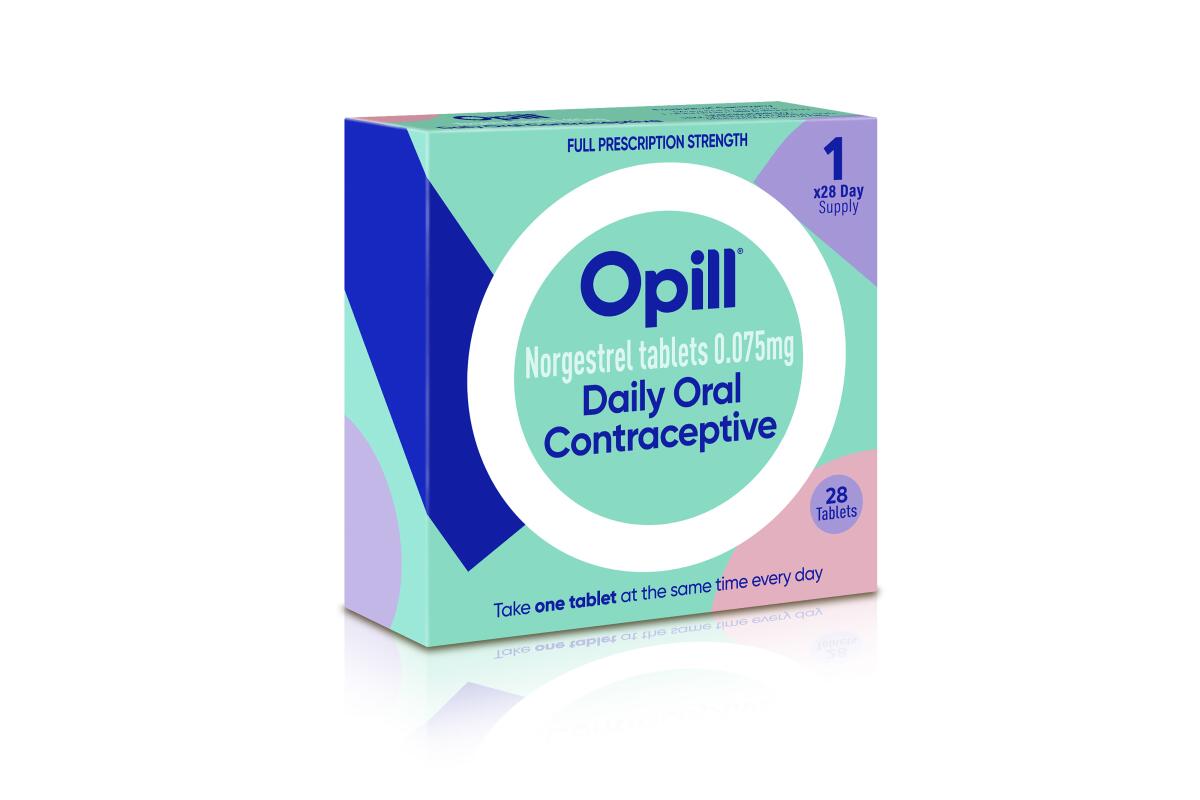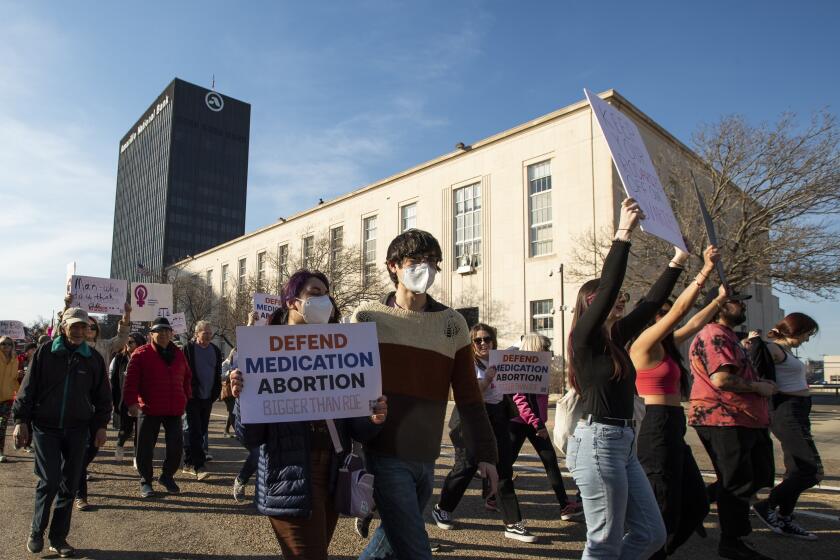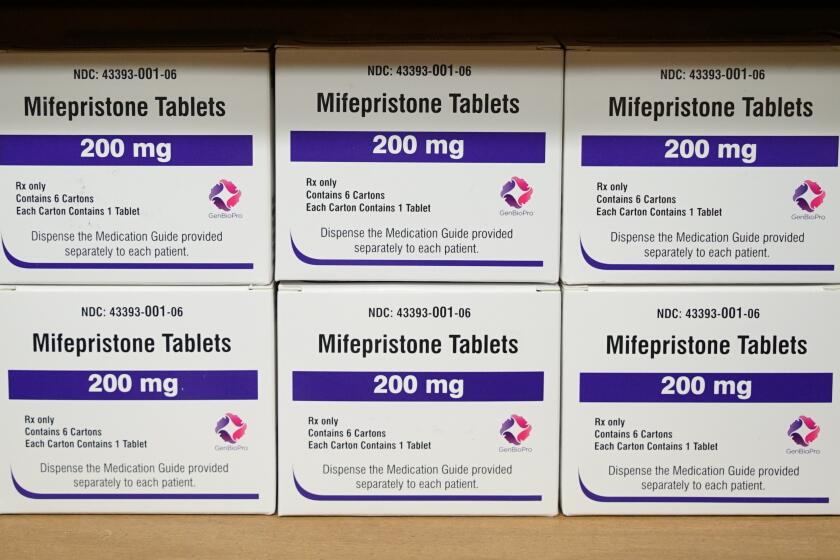FDA approves nation’s first over-the-counter birth control pill

- Share via
WASHINGTON — Federal regulators approved the first over-the-counter birth control pill Thursday, in a landmark decision that will soon allow American women and girls to obtain contraceptive medication as easily as they buy aspirin and eyedrops.
The Food and Drug Administration said that it cleared Perrigo’s once-a-day Opill to be sold without a prescription, making it the first such medication to be moved out from behind the pharmacy counter. The company won’t start shipping the pill until early next year, and there will be no age restrictions on sales.
Hormone-based pills have long been the most common form of birth control in the U.S., used by tens of millions of women since the 1960s. Until now, all of them required a prescription.
Medical societies and women’s health groups have pushed for wider access, noting that an estimated 45% of the 6 million annual pregnancies in the U.S. are unintended. Teens and girls, women of color and those with low incomes report greater hurdles in getting prescriptions and picking them up.
Some of the challenges can include paying for a doctor’s visit, getting time off from work and finding child care.
“This is really a transformation in access to contraceptive care,” said Kelly Blanchard, president of Ibis Reproductive Health, a nonprofit group that supported the approval. “Hopefully this will help people overcome those barriers that exist now.”
The Times looked into a male birth control that sounds promising, as well as the bigger debate about reproductive justice.
Ireland-based Perrigo says Opill could be an important new option for the estimated 15 million U.S. women who currently use no birth control or less effective methods, such as condoms. They are a fifth of women who are child-bearing age.
But how many women will actually gain access depends on the medication’s price, which Perrigo plans to announce later this year.
“The reason why so many of us worked tirelessly for years to get over-the-counter birth control pills is to improve access ... cost shouldn’t be one of those barriers,” said Dr. Pratima Gupta of the American College of Obstetricians and Gynecologists.
Most older birth control pills cost $15 to $30 for a month’s supply without insurance coverage.
Over-the-counter medicines are generally much cheaper than prescriptions, but they typically aren’t covered by insurance.
Forcing insurers to cover over-the-counter birth control would require a regulatory change by the federal government, which women’s advocates are urging the Biden administration to implement.
The FDA approval gives U.S. women another birth control option amid the legal and political battles over reproductive health, including last year’s reversal of Roe v. Wade, which has upended abortion access across the U.S.
That said, Opill’s approval is unrelated to the ongoing court battles over the abortion pill mifepristone. And anti-abortion groups have generally emphasized that they do not oppose contraceptives, which are used to prevent pregnancies, not end them.
However, that has done little to ease fears that contraception could someday become a target. When the Supreme Court overturned Roe, Justice Clarence Thomas wrote a separate opinion in which he explicitly called on his colleagues to put the high court’s same-sex marriage, gay sex and contraception cases on the table.
In the last year, the FDA has faced pressure from Democratic politicians, health advocates and medical professionals to improve access to birth control. The American Medical Association and other leading medical groups backed Opill’s application for over-the-counter status.
Birth control pills are available without a prescription across much of South America, Asia and Africa.
Perrigo submitted years of research to the FDA to show that women could understand and follow instructions for using the pill. Thursday’s approval came despite some concerns by FDA scientists about the company’s results, including whether women with certain underlying medical conditions would understand that they shouldn’t take the drug.
The FDA’s action applies only to Opill. It’s in an older class of contraceptives, sometimes called minipills, that contain a single synthetic hormone and generally carry fewer side effects than more popular combination hormone pills.
Iowa’s Republican-led Legislature has passed a bill banning most abortions after roughly six weeks of pregnancy, before many women know they are pregnant.
But women’s health advocates hope the decision will pave the way for more over-the-counter birth control options and, eventually, for abortion pills as well.
An outside panel of FDA advisors unanimously voted in favor of the switch at a hearing in May where dozens of public speakers called for Opill’s approval.
Danco Laboratories, which makes the abortion pill mifepristone, doesn’t disclose its headquarters address, chief executive, board members or investors because of threats.
Dyvia Huitron was among those who spoke, explaining how she has been unable to get prescription birth control more than three years after becoming sexually active. The 19-year-old University of Alabama student said she still isn’t comfortable getting a prescription because the school’s health system reports medical exams and medications to parents.
“My parents did not let me go on the pill,” Huitron said in a recent interview. “There was just a lot of cultural stigma around being sexually active before you’re married.”
While she uses other forms of contraception, “I would have much preferred to have birth control and use these additional methods to ensure that I was being as safe as possible.”
Huitron spoke on behalf of Advocates for Youth, one of the dozens of groups that have pushed to make prescription contraceptives more accessible.
The groups helped fund some of the studies submitted for Opill, and they encouraged HRA Pharma, later acquired by Perrigo, to file its application with the FDA.
Opill was first approved in the U.S. five decades ago but hasn’t been marketed here since 2005.
“It’s been around a long time, and we have a large amount of data supporting that this pill is safe and effective for over-the-counter use,” said Blanchard of Ibis Reproductive Health.
Newer birth control pills typically combine two hormones, estrogen and progestin, which can help make periods lighter and more regular. But their use carries a heightened risk of blood clots, and they shouldn’t be used by women at risk for heart problems, such as those who smoke and are over 35.
The Supreme Court said it was temporarily keeping in place FDA rules for the abortion drug mifepristone while it more fully considers issues.
Opill has only progestin, which prevents pregnancy by blocking sperm from reaching the cervix. It must be taken around the same time daily to be most effective.
In its internal review published in May, the FDA noted that some women in Perrigo’s study had trouble understanding the drug’s labeling information. In particular, the instructions warn that women with a history of breast cancer should not take the pill because it could spur tumor growth. And women who have unusual vaginal bleeding are instructed to talk to a doctor first, because it could indicate a medical problem.
Common side effects include irregular vaginal bleeding, headaches, dizziness and cramps, according to the FDA. The label also cautions that certain drugs can interfere with Opill’s effectiveness, including medications for seizures, HIV and hypertension.
Perrigo executives said the company will spend the rest of the year manufacturing the pill and its packaging so that it can be available in stores nationwide and online by early next year.










